

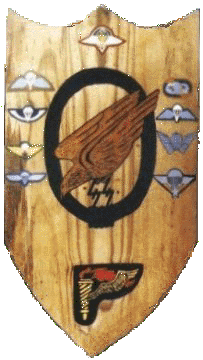


The Drop
At 07H30 the jumpmasters gave the command "Stick , stand up ! ! "
The heavily laden troops struggled to their feet, and on the command "Hook
up!" , each man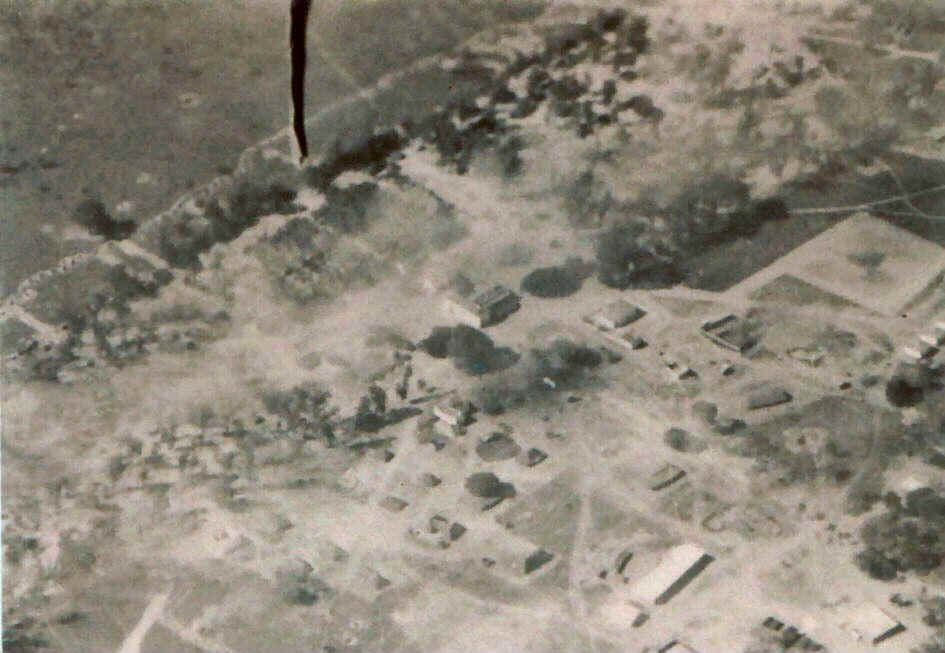 snapped his static line onto the steel cable running the length of fuselage,
before the the command " Check equipment ! !" came each man had
already started to check the man in front of his gear, now the joking that had
surfaced al too briefly on the trip had disappeared, every man knew that this
was for real, the time had come for each to face the fact that they might not
see the end of this day ...
snapped his static line onto the steel cable running the length of fuselage,
before the the command " Check equipment ! !" came each man had
already started to check the man in front of his gear, now the joking that had
surfaced al too briefly on the trip had disappeared, every man knew that this
was for real, the time had come for each to face the fact that they might not
see the end of this day ...
The five minute warning blared through the eight transports as they swept
over Angola at a height of eighty meters , then the pilots pulled back on the
sticks and when the planes reached an altitude of 180 meters they leveled off,
the klaxon sounding the 1 minute warning , pilots easing up on the throttle.....
next warning ......the jumpmaster shouting "Action Stations ! !" by
now the stick leader in the doorway... hands holding onto the doorway ,wind
buffeting his face and body , left foot on the edge, body braced to propel
himself out, eyes on the light.... then its green! forward into the slipstream ,
body twisting towards the rear, "Must stay vertical, keep feet together,
arms wrapped round the reserve 'chute ! "...... a slight tug, then a crack,
and then the welcome jolt as the T10 opens. "Glance
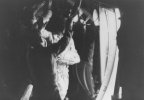 upwards....check 'chute ......
thank God !,no malfunction..... look down, Dear God, we have been dropped off
target......cant worry about that now....the wind is blowing me across the
river... pull on risers to try and steer away...., what's that .....? SWAPO shooting at me !!! .... got to get get down.... spill air out of canopy..... Big
mistake!! ... almost saw my Arse there.... ground coming up..... watch that
tree.... try to remember training, feet together...... watch ground.... snapping
sounds in the air, suddenly the realisation that the last time I heard that
sound it was at Skurweberg shooting range !! .....the bastards are getting the
range !!.... Suddenly the ground is a metre away.... brace for impact...
wrong... ! remember roll on thigh , then on shoulder .... THUMP ... breath
driven out of body...... try to get up...... almost succeeded..... 'chute
dragging me..... hit quick release .. roll out of harness..... get R3,
release magazine... smack against " Staaldak" to seat
rounds...... insert mag......pull back cocking handle........ check barrel.....
no dirt ..... set on single fire......heart thumping audibly ..... where is
everybody.........!!!
upwards....check 'chute ......
thank God !,no malfunction..... look down, Dear God, we have been dropped off
target......cant worry about that now....the wind is blowing me across the
river... pull on risers to try and steer away...., what's that .....? SWAPO shooting at me !!! .... got to get get down.... spill air out of canopy..... Big
mistake!! ... almost saw my Arse there.... ground coming up..... watch that
tree.... try to remember training, feet together...... watch ground.... snapping
sounds in the air, suddenly the realisation that the last time I heard that
sound it was at Skurweberg shooting range !! .....the bastards are getting the
range !!.... Suddenly the ground is a metre away.... brace for impact...
wrong... ! remember roll on thigh , then on shoulder .... THUMP ... breath
driven out of body...... try to get up...... almost succeeded..... 'chute
dragging me..... hit quick release .. roll out of harness..... get R3,
release magazine... smack against " Staaldak" to seat
rounds...... insert mag......pull back cocking handle........ check barrel.....
no dirt ..... set on single fire......heart thumping audibly ..... where is
everybody.........!!!
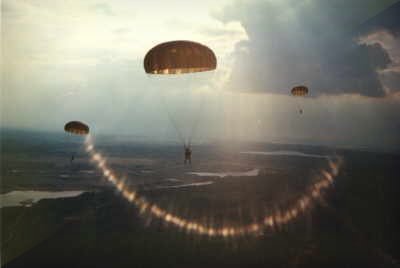 After the attack aircraft had finished their bombing runs the six transports, which had been orbiting in wait some miles to the east, commenced their formation run towards Cassinga at 200 feet (60 m). Shortly before reaching the base, the six aircraft climbed to 600 feet,
After the attack aircraft had finished their bombing runs the six transports, which had been orbiting in wait some miles to the east, commenced their formation run towards Cassinga at 200 feet (60 m). Shortly before reaching the base, the six aircraft climbed to 600 feet,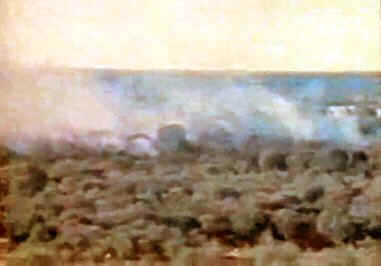 the drop height, and lined up for the drop. However, needed visual 'tracking and distance' co-ordination markers were obscured by smoke from the bombing run, the DZ box scaling and drop point distances were incorrect - due to the reconnaissance scaling errors - and the drop was a shambles with nearly all the paratroopers being dropped off-target, some into tall maize where they had problems linking up. The resultant confusion resulted in numerous delays, ruining the schedule of the 'Drop-to-contact' plan, and much of the benefit of surprise. The disastrous drop also meant that it would be nearly an hour before C-Company was able to move into position on the eastern side of the camp and seal off the escape routes, with the result being that a number of top PLAN commanders, including Dimo Amaambo (one of the principle targets of the attack) were able to escape.The
drop had been a disaster, one crew from the Canberra squadron had been tasked with acquiring further photo-reconnaissance imagery, some to be used in the preparation of
photo-strip maps for the T
the drop height, and lined up for the drop. However, needed visual 'tracking and distance' co-ordination markers were obscured by smoke from the bombing run, the DZ box scaling and drop point distances were incorrect - due to the reconnaissance scaling errors - and the drop was a shambles with nearly all the paratroopers being dropped off-target, some into tall maize where they had problems linking up. The resultant confusion resulted in numerous delays, ruining the schedule of the 'Drop-to-contact' plan, and much of the benefit of surprise. The disastrous drop also meant that it would be nearly an hour before C-Company was able to move into position on the eastern side of the camp and seal off the escape routes, with the result being that a number of top PLAN commanders, including Dimo Amaambo (one of the principle targets of the attack) were able to escape.The
drop had been a disaster, one crew from the Canberra squadron had been tasked with acquiring further photo-reconnaissance imagery, some to be used in the preparation of
photo-strip maps for the T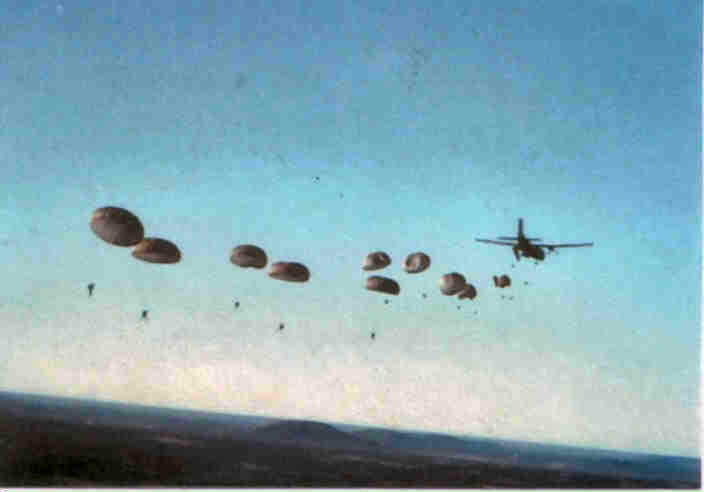 actical Low Flying ( TLF ) legs that the various aircraft types would undertake - there being inadequate conventional mapping of much of the region - and additional imagery of the Cassinga environs for
the DZ and Buccaneer target planning purposes. It was during this that a serious error was made, with
serious consequences.
actical Low Flying ( TLF ) legs that the various aircraft types would undertake - there being inadequate conventional mapping of much of the region - and additional imagery of the Cassinga environs for
the DZ and Buccaneer target planning purposes. It was during this that a serious error was made, with
serious consequences.
The targeting imagery was taken from 23000 feet instead of the briefed 33000 feet, the pilot unaccountably misreading his altimeter. The navigator/sensors operator was unaware of this, and the post-flight data sheet accompanying the reels of processed imagery went off to the Photo-Interpretation Centre indicating the higher height. This material
found its way to the Hercules Squadron, where planners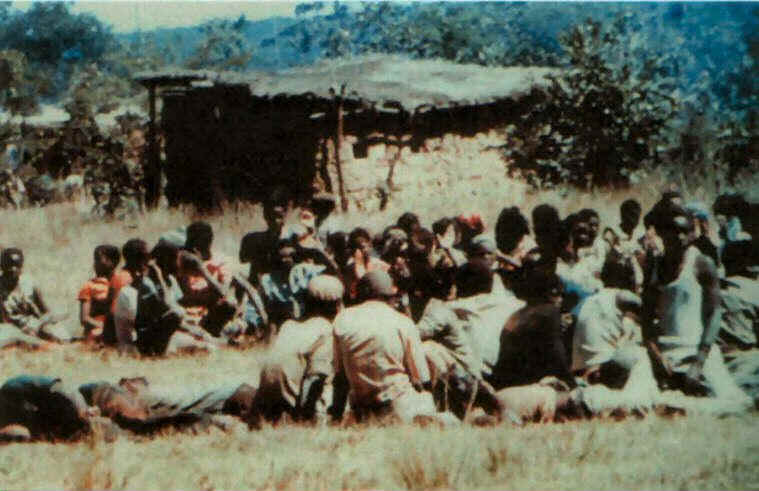 unwittingly miscalculated areas and distances -
using the erroneous height data - including the crucial ground positions for the jump 'Go' order to the sticks of Parabats. Consequently, many overshot their intended DZs. One or two very experienced
C130 pilots modified their drop-plan in the last moments of their approach-to-drop, on their 'sight picture' alone.
Due to the smoke
unwittingly miscalculated areas and distances -
using the erroneous height data - including the crucial ground positions for the jump 'Go' order to the sticks of Parabats. Consequently, many overshot their intended DZs. One or two very experienced
C130 pilots modified their drop-plan in the last moments of their approach-to-drop, on their 'sight picture' alone.
Due to the smoke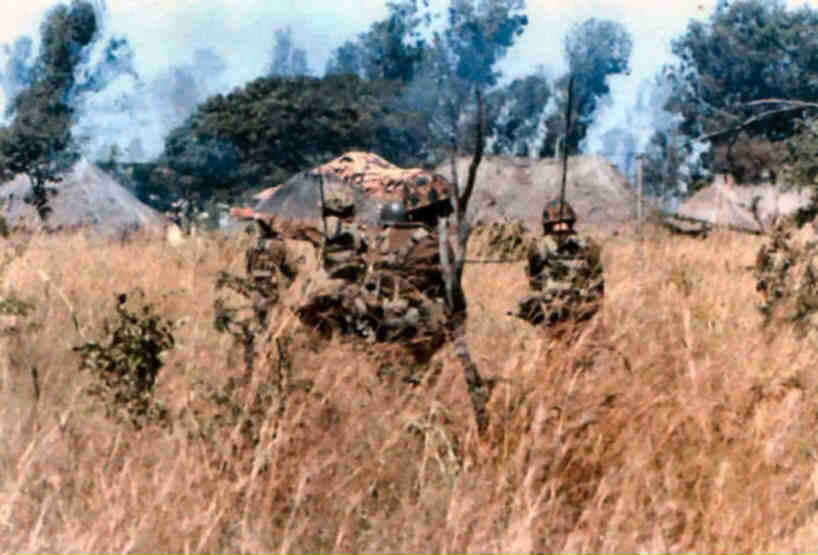 and dust caused by the air strike
some pilots were unable to see their markers, and had to time the jump by dead
reckoning, this resulted in some troops being dropped 3 seconds late , on a LZ
450 metres wide between a river bend is a hell of a distance, added to this was
the fact that a strong NE wind was gusting, blowing the 'Bats even further off
course. Bravo and most of Alpha companies landed on the wrong side of the river,
and those who landed on the east side , landed far further south than they had
planned , the command element were also on the wrong side of the river,
including the two FACs , the most of the mortar platoon as well as the sappers.
Both doctors, Brig Du Plessis and the rest of the mortar platoon landed in the
river, most of them had to jettison their gear to stop themselves from drowning
as soon as they hit the water...... this would cause a lot of hardship
later on....
and dust caused by the air strike
some pilots were unable to see their markers, and had to time the jump by dead
reckoning, this resulted in some troops being dropped 3 seconds late , on a LZ
450 metres wide between a river bend is a hell of a distance, added to this was
the fact that a strong NE wind was gusting, blowing the 'Bats even further off
course. Bravo and most of Alpha companies landed on the wrong side of the river,
and those who landed on the east side , landed far further south than they had
planned , the command element were also on the wrong side of the river,
including the two FACs , the most of the mortar platoon as well as the sappers.
Both doctors, Brig Du Plessis and the rest of the mortar platoon landed in the
river, most of them had to jettison their gear to stop themselves from drowning
as soon as they hit the water...... this would cause a lot of hardship
later on....
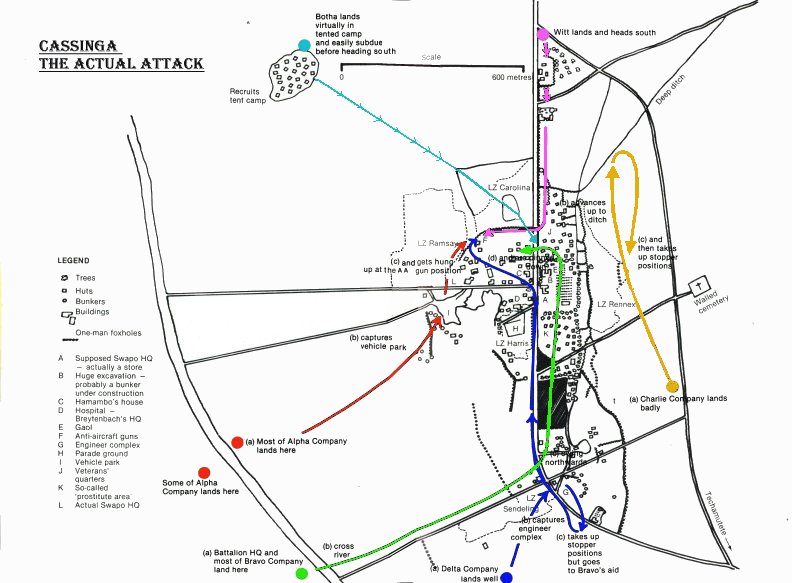
Instead of of landing on the outskirts of the town Witt's platoon landed east of the Techamutete road, 400 metres NE of the first target, to add to their woes the area they had landed in was dotted with tall trees, and heavily bushed a fair number of the 'Bats found themselves dangling 12 to 15 metres above the ground. Despite this at 08H30 his platoon was ready to take their target and was waiting for the go-ahead at the intersection , 2 sections were deployed east of the road and his fire support team on the western side.
Luckily for the South Africans Jan Breytenbach and Gerrit Swart of Alpha Coy had landed on the eastern bank of the river. Swart immediately established comms with Battalion HQ and after learning that they were on the wrong side of the river got what remained of his company together and started moving east whilst engaged in this he shepherded his lost flock towards him via radio. Away from the bank he found a a dirt track that he was able to plot , at least he knew where he was , on the diagonal road west of the engineering complex. After reporting to Jan Breytenbach on the Company net he received a new set of orders, the direction of the attack had been changed as a result of the near disastrous drop, it would now have a South-North instead of a West-East axis. Phase one of the attack had been scrapped as most of the assault group was on the wrong side of the river.
A new problem raised its head , whilst in the air the 'Bats became aware that they were being fired on by 14.5 mm machine guns, this was anew to development at no time did the South Africans suspect that SWAPO had these sited in the camp.. the heaviest weapons the South Africans expected was 12.7 mm machine guns .
These would prove to a tough nut to crack in the ground fighting that was to follow . During WWII the Germans quite often used 20mm Flak-Vierling or Flak-Zwilling in a ground role against the Russians with tremendous success, Ivan had learnt these lessons well and SWAPO would prove to be diligent pupils.
Botha landed virtually on top of his target and he and his
men wasted no time in clearing it , the resistance was not as fierce as had been
expected as the SWAPO recruits were still reeling from the pasting they had
received in the aerial attack. Those who had foolishly decided to take the
‘Bats on died where they decided to make their stand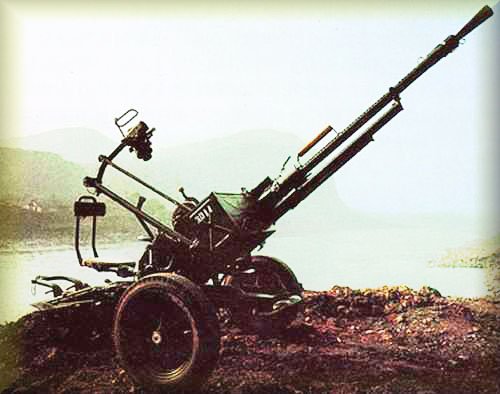
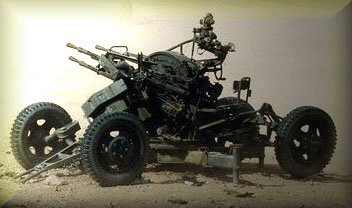
Delta Coy had jumped from a mere 250 metres and they were the first to hit the deck , on the way down they drew a considerable amount of AAA, MG and small-arms fire but this was inaccurate, the SWAPO gunners were inexperienced and did not lead their targets. Despite this Delta landed way west from their intended DZ. Tommy Smit popped a smoke as a marker and established comms with Breytenbach. Delta’s regrouping was almost surreal, in fact the lack of opposition on the ground was rather unnerving .
Charlie Coy landed 3 kilometres south from where they were
supposed to land, despite this they were drawing ground fire on the way down. To
the south of them they could see a plume of smoke and in the distance the sound
of a fire-fight. Like a Napoleonic Marshall , Monty Forbes decided to
march to the “ Sound of the 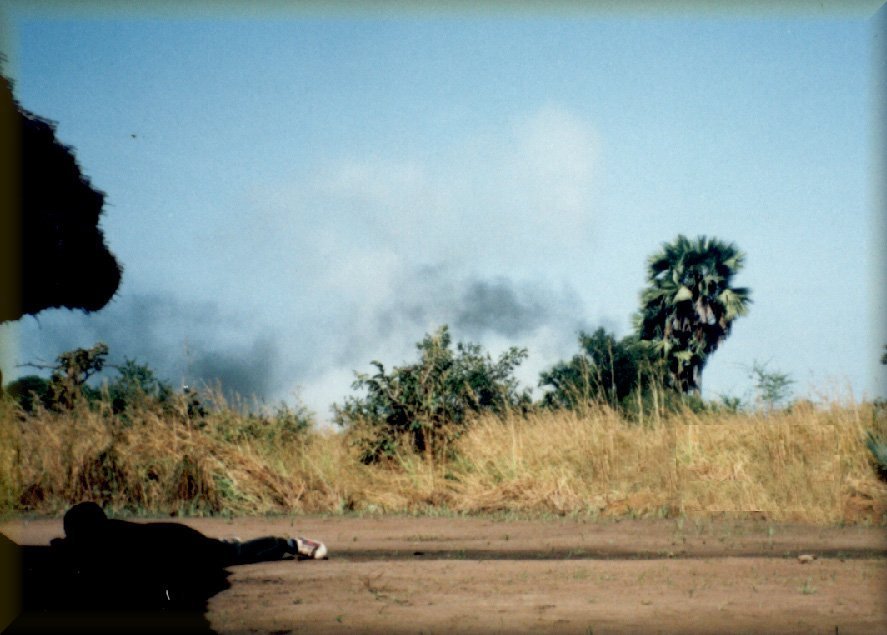 Guns”.
In single file he and his men moved south until they hit a a road with a road
sign saying “Cassinga” at this he swung northwest and eventually reached
Delta’s main target, the engin
Guns”.
In single file he and his men moved south until they hit a a road with a road
sign saying “Cassinga” at this he swung northwest and eventually reached
Delta’s main target, the engin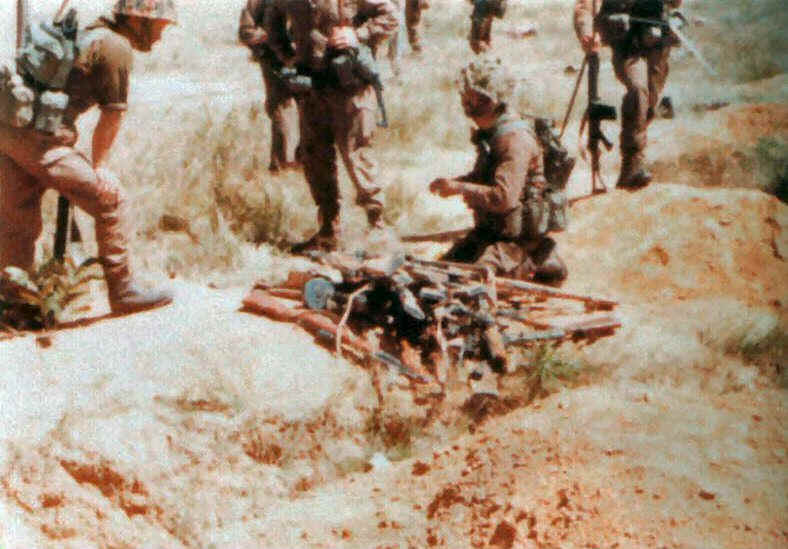 eering complex , at this junction Delta appeared
out of the blue .Charlie then moved northwards to their allotted position,
finally arriving 1.75 hours later than they were supposed to.
eering complex , at this junction Delta appeared
out of the blue .Charlie then moved northwards to their allotted position,
finally arriving 1.75 hours later than they were supposed to.
All of Bravo landed up on the western bank of the Cubango river some 2000 metres from where they were supposed to be and to boot on the wrong side of the river, they could hear the roar of heavy machineguns to the north of them and deduced that the target lay in that direction .The company regrouped and started moving towards the sound of gunfire looking for a suitable crossing place .
Alpha set of using the diagonal road as the axis of their advance , only stopping to wipe out small groups of SWAPO terrorists who were hindering their progress, these groups did not pose anything more than nuisance value for the 'Bats, behind them the command group of Breytenbach, the vanguard consisted of the section of Alpha who had landed on the wrong side of the river who at long last had found a crossing place.
Jan Breytenb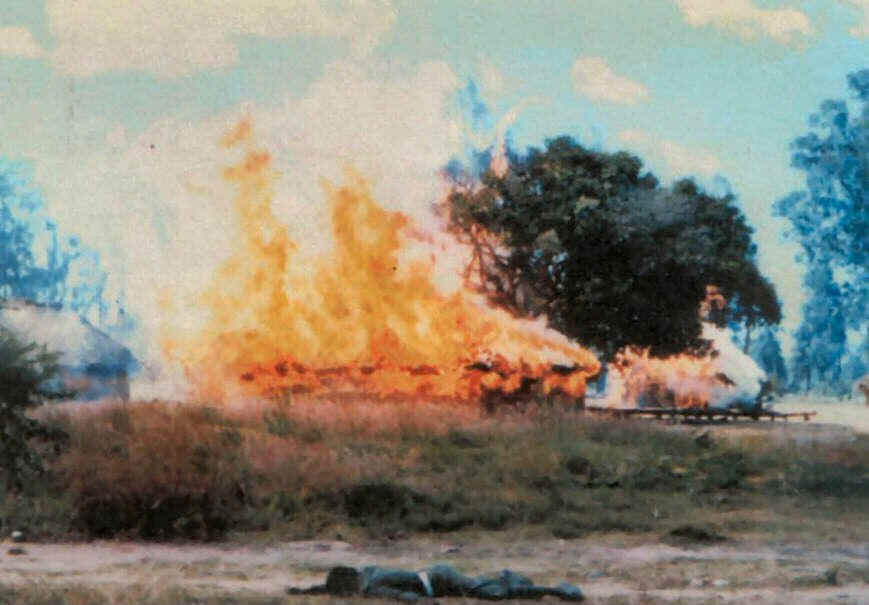 ach was not unduly disturbed by this new
scenario, being an experienced soldier he knew that in real life one had to be
flexible on the battlefield , af
ach was not unduly disturbed by this new
scenario, being an experienced soldier he knew that in real life one had to be
flexible on the battlefield , af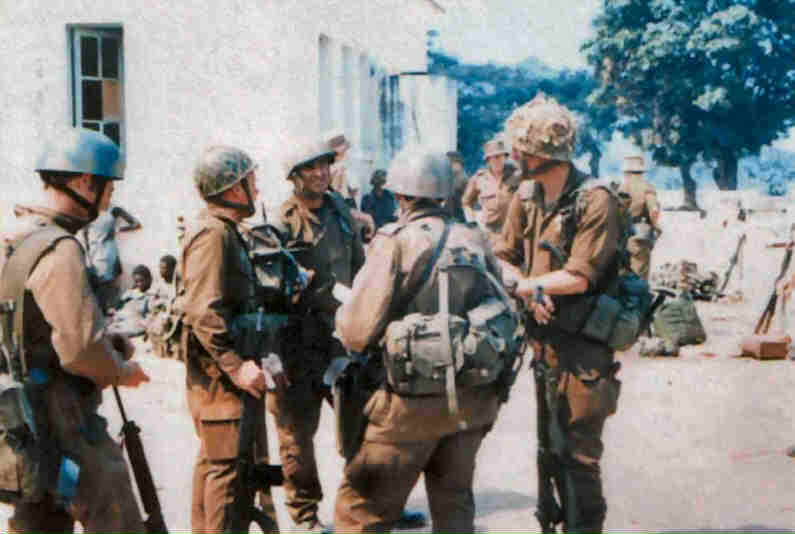 ter all Witt and Botha’s forces were intact
and they were already engaging the enemy , Delta was in place in the south and
would be attacking its target, the engineering complex
in due course, it was obvious that SWAPO had been caught unawares and at present
were disorganised, every second that this state of affairs lasted acted in the
South Africans favour . Lucky for the 'Bats the defenders was still reeling from
the air strike but with every second they were regaining their composure,
notwithstanding the fact that most of the leadership element had been wiped out
when the ground support Buccaneer had blasted the suspected HQ and adjacent
building with a volley of 39 rockets ,the long delay between the air strike and
the ground attack gave SWAPO plenty of time to occupy their fighting positions
and to get ready to repulse the attack when it came…
ter all Witt and Botha’s forces were intact
and they were already engaging the enemy , Delta was in place in the south and
would be attacking its target, the engineering complex
in due course, it was obvious that SWAPO had been caught unawares and at present
were disorganised, every second that this state of affairs lasted acted in the
South Africans favour . Lucky for the 'Bats the defenders was still reeling from
the air strike but with every second they were regaining their composure,
notwithstanding the fact that most of the leadership element had been wiped out
when the ground support Buccaneer had blasted the suspected HQ and adjacent
building with a volley of 39 rockets ,the long delay between the air strike and
the ground attack gave SWAPO plenty of time to occupy their fighting positions
and to get ready to repulse the attack when it came…
Even as the paratroopers were landing SWAPO were
mounting local counter-attacks to try and neutralise them , a paratrooper is at
his most v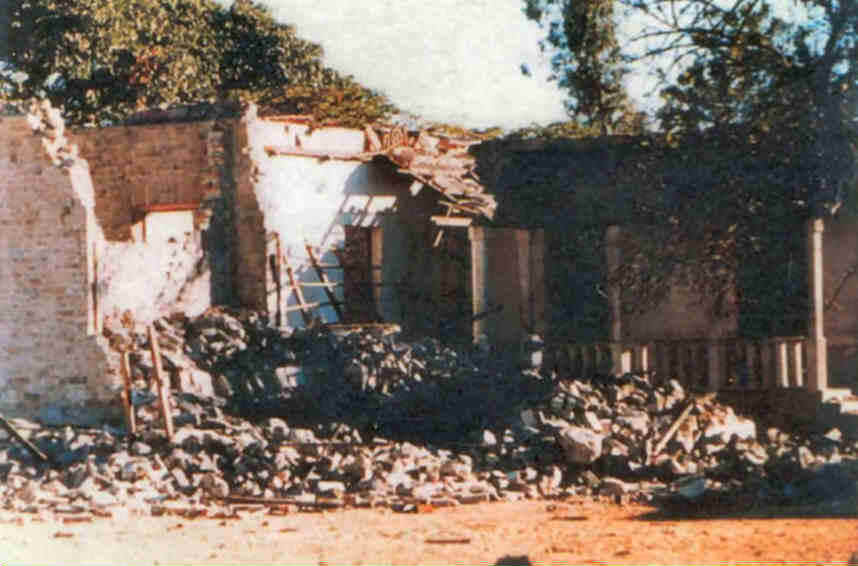 ulnerable when he lands, if you allow him to dump his 'chute and link
up with another paratrooper you've lost your chance. What Breytenbach did not
know was the fact that Dimo Hamambo the SWAPO Commanding Officer whose death or
capture had been one of the raids objectives, had fled and deserted his men
immediately after the air strike
ulnerable when he lands, if you allow him to dump his 'chute and link
up with another paratrooper you've lost your chance. What Breytenbach did not
know was the fact that Dimo Hamambo the SWAPO Commanding Officer whose death or
capture had been one of the raids objectives, had fled and deserted his men
immediately after the air strike
Alpha swung Northeast and had a fairly uneventful trek until they hit the vehicle park where a group of SWAPO decided to make a stand , the platoon on Swart’s left quickly dealt with these, amongst the dead was a female Terr dressed in East German fleck camouflage , she had been shot in the neck whilst firing at the ‘Bats with a SKS.
One determined Terr held out from under a bus that had been
hijacked from South West Africa a couple of weeks previously and it proved
virtually impossible to neutralise him without destroying the bus ,( the South
African troops had strict instructions not to destroy any vehicles as
SWAPO would use this as a pro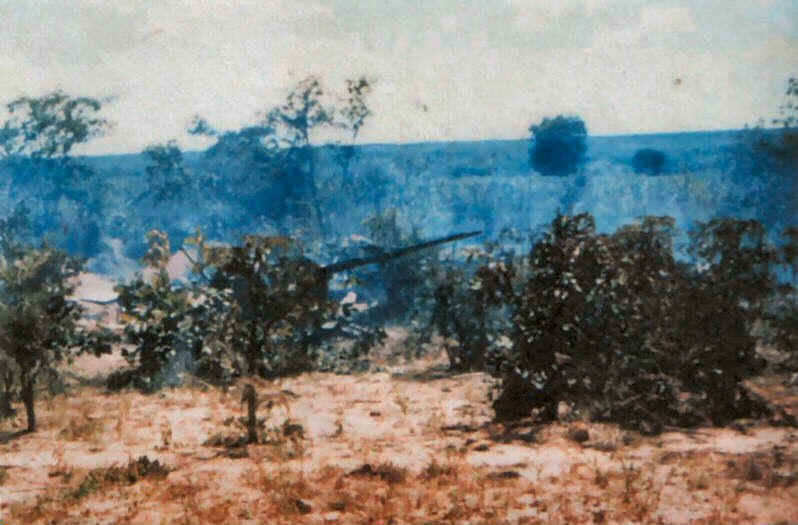 paganda ploy) after a while the problem was
resolved as the Terr exhausted his ammunition threw out his weapon and
crawled out from his hiding place, pronouncing to all and sundry that he was a POW, and that nobody
could shoot him now. These words of wisdom was lost on one rather
pissed off ‘Bat who promptly showed the Terr that he
was dead wrong in more ways than one that score . They could now pay
attention to a bunker who had been a thorn in their side during the fight for
the vehicle park, 5 Terrs were holed up in there, and while some troops fired at
the firing slits of the bunker, keeping the Terrs occupied, another ‘Bat
crawled forward and popped a grenade inside which solved that particular problem
for good.
paganda ploy) after a while the problem was
resolved as the Terr exhausted his ammunition threw out his weapon and
crawled out from his hiding place, pronouncing to all and sundry that he was a POW, and that nobody
could shoot him now. These words of wisdom was lost on one rather
pissed off ‘Bat who promptly showed the Terr that he
was dead wrong in more ways than one that score . They could now pay
attention to a bunker who had been a thorn in their side during the fight for
the vehicle park, 5 Terrs were holed up in there, and while some troops fired at
the firing slits of the bunker, keeping the Terrs occupied, another ‘Bat
crawled forward and popped a grenade inside which solved that particular problem
for good.
Now it was a case of clearing the remainder of the enemy
trench system that had been laid out according to Soviet Army doctrine, the
drill was grenade into the trench, wait for the explosion, then in with rifle
and grenade to clear out any remaining survivors, check the enemy dead to make
sure that they st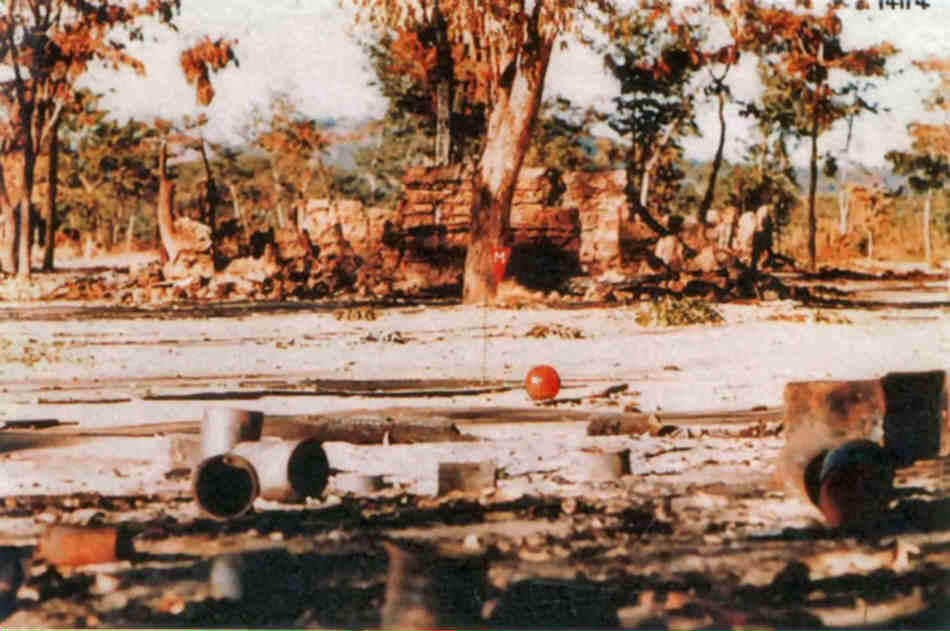 ayed dead, some Bats would
only cursorily check enemy
casualties, others would check thoroughly, and some would use the simple
expedient of shooting the corpse in the head to be really sure. During this
phase of the operation 3 members of the ‘Bats would win the Honoris Crux.
ayed dead, some Bats would
only cursorily check enemy
casualties, others would check thoroughly, and some would use the simple
expedient of shooting the corpse in the head to be really sure. During this
phase of the operation 3 members of the ‘Bats would win the Honoris Crux.
Rfn Johan van der Merwe was a member of the stopper group assigned to ambush SWAPO terrs who decided to flee , during the attack he constantly kept on drawing fire so that the enemy positions could be noted, and on more than one occasion he risked his own life to protect his company commander, on one occasion his unit was pinned down in front of an enemy strongpoint and with remarkable sang-froid he commenced to lay down intense covering fire, which distracted the enemy while the strongpoint was flanked and knocked out, sometime during the attack he took an AK47 round in his Staaldak which missed his head completely .
After mopping up Alpha continued in a north-easterly meeting
light to moderate resistance , this was to change until they reached the left
hand side of the Carolina/Boskop DZ and walked into veritable hail
of fire from two 12.7 mm DschK and one 14.5 mm Anti-aircraft machine guns that
SWAPO now deployed in a ground role seeing that there was no threat from the
SAAF. The ‘Bats were in trouble, any movement drew heavy fire, the Terrs
manning the guns were no “refugees” the enemy knew their job and there were
wounded South Africans out in the open. SWAPO were using these as bait, hoping
to draw the ‘Bats into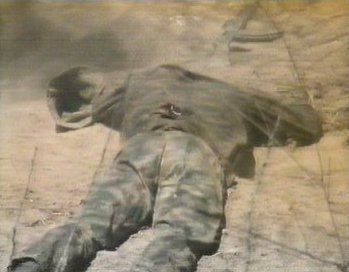 attempting
a rescue and getting
themselves killed whilst doing this. WO Reeves was pinned down and wounded
, unable to move, every time he did so, he drew fire. Rfn Dale Packham, who had
earlier saved a buddy RFN Kochman, who had been wounded
by the same
attempting
a rescue and getting
themselves killed whilst doing this. WO Reeves was pinned down and wounded
, unable to move, every time he did so, he drew fire. Rfn Dale Packham, who had
earlier saved a buddy RFN Kochman, who had been wounded
by the same 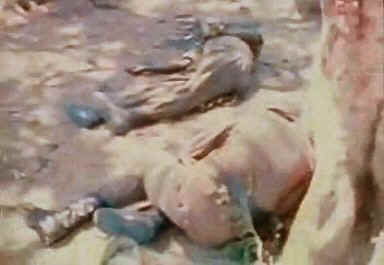 machine-gun and lying in the open, decided to repeat the
performance. Regardless of the risk involved he crossed the open ground in front
of the 14.5 mm machine gun, the SWAPO gunners spotted him, and with dust being
kicked up around his feet by bullets striking the ground he managed to scramble
to a better firing position, once there he opened fire on the machine-gun with
accurate shots which caused the gunner to hit the deck, thus enabling Reeves to
move into covered. Unfortunately Packham exposed himself to the
SWAPO gunners a fraction too long and he was hit in the chest and arm by a burst
of machine-gun fire he staggered forward and collapsed in a doorway of a hut,
Cpl Delville Engelbrecht immediately ran to help him under intense fire ,
dragged Packham into cover and started dressing his wounds, after stabilising
his friend he then braved the SWAPO fire and ran to his Company HQ to
report that Packham was seriously wounded and that the fire had to be
neutralised so that the wounded ‘Bat could be evacuated. Despite the odds he
then ran through the enemy fire a third time to his wounded buddy to await help.
machine-gun and lying in the open, decided to repeat the
performance. Regardless of the risk involved he crossed the open ground in front
of the 14.5 mm machine gun, the SWAPO gunners spotted him, and with dust being
kicked up around his feet by bullets striking the ground he managed to scramble
to a better firing position, once there he opened fire on the machine-gun with
accurate shots which caused the gunner to hit the deck, thus enabling Reeves to
move into covered. Unfortunately Packham exposed himself to the
SWAPO gunners a fraction too long and he was hit in the chest and arm by a burst
of machine-gun fire he staggered forward and collapsed in a doorway of a hut,
Cpl Delville Engelbrecht immediately ran to help him under intense fire ,
dragged Packham into cover and started dressing his wounds, after stabilising
his friend he then braved the SWAPO fire and ran to his Company HQ to
report that Packham was seriously wounded and that the fire had to be
neutralised so that the wounded ‘Bat could be evacuated. Despite the odds he
then ran through the enemy fire a third time to his wounded buddy to await help.
SWAPO might have been caught off guard with the air attack and the air assault, but they quickly recovered , and the Parabats quickly realised they had a stiff fight on their hands, a Cuca shop in the vicinity of the crossroads close by the engineering complex, offered stiff resistance, and it was finally taken after the 'Bats managed to lob grenades through the windows, after the explosions they moved in and silenced the occupants with grenade and bayonet. The SWAPO occupants died hard, these were no so-called "refugees" and they earned the grudging respect of their South African opponents .
As s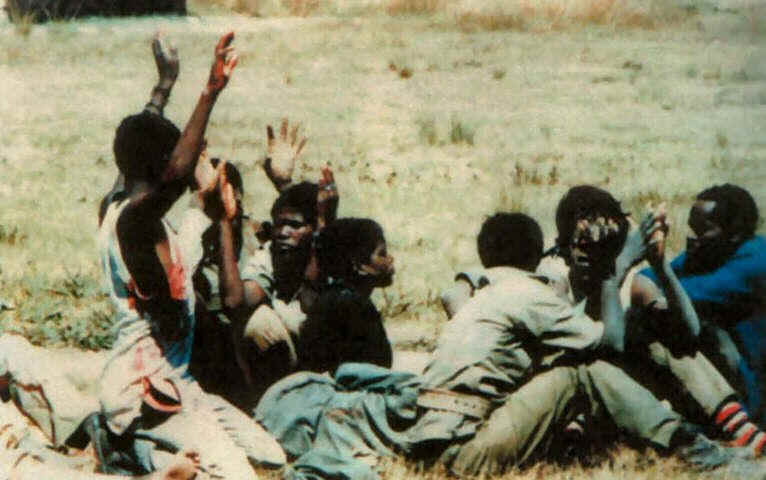 oon as the Cuca shop had been secured the South Africans started moving up to
the line of trees towards the SWAPO HQ, a group of SWAPO terrorists were holed
up in the four buildings to the west of the parade ground, and they started
firing at the advancing South Africans , stalling their advance , Sergeant
Coertze quickly silenced them with 4 well placed RPG 7 rounds and the survivors
were picked off as they vacated the ruins, two South Africans grenaded the
buildings , and once they were secured the South Africans resumed their advance
towards the SWAPO HQ, where they found three 44 gallon drums that had been
converted into pots, bubbling away filled with Mealiepap , that should have been
the HQ occupants' breakfast. while all this was going on the 'Bats could still
hear the uninterrupted roar of SWAPO' s heavy machine guns , interspersed with the
"crump" of the South African 60mm mortars trying to silence these.
oon as the Cuca shop had been secured the South Africans started moving up to
the line of trees towards the SWAPO HQ, a group of SWAPO terrorists were holed
up in the four buildings to the west of the parade ground, and they started
firing at the advancing South Africans , stalling their advance , Sergeant
Coertze quickly silenced them with 4 well placed RPG 7 rounds and the survivors
were picked off as they vacated the ruins, two South Africans grenaded the
buildings , and once they were secured the South Africans resumed their advance
towards the SWAPO HQ, where they found three 44 gallon drums that had been
converted into pots, bubbling away filled with Mealiepap , that should have been
the HQ occupants' breakfast. while all this was going on the 'Bats could still
hear the uninterrupted roar of SWAPO' s heavy machine guns , interspersed with the
"crump" of the South African 60mm mortars trying to silence these.
Bravo company by this time had cleared out the brothel area of
the camp, and although they were receiving sporadic sniper fire, all resistance
in their immediate vicinity seemed to have ceased, to the north of the HQ they
spotted 3 terrs dragging a 82mm recoilless rifle across the road leading to
Techamutete, Bravo took them under fire , but the distance was to great for
Bravo's fire to be effective, the terrs took exception to this , and opened fire
with the recoilless rifle, luckily for Bravo the round sailed har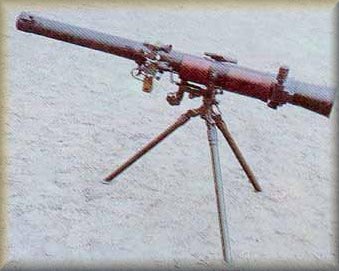 mlessly over
their heads and exploded 200 meters down the road, the terrs decided that
discretion was the better part of valour and disappeared gun and all into the
bushes by the side of the road. The area in front of the HQ building was covered
in corpses, the Golf bombs of the Canberra bombs had reaped a grim harvest , and
more than one South African soldier was shocked at the sight of so many dead and
mutilated bodies, this was war, and a lot of t
mlessly over
their heads and exploded 200 meters down the road, the terrs decided that
discretion was the better part of valour and disappeared gun and all into the
bushes by the side of the road. The area in front of the HQ building was covered
in corpses, the Golf bombs of the Canberra bombs had reaped a grim harvest , and
more than one South African soldier was shocked at the sight of so many dead and
mutilated bodies, this was war, and a lot of t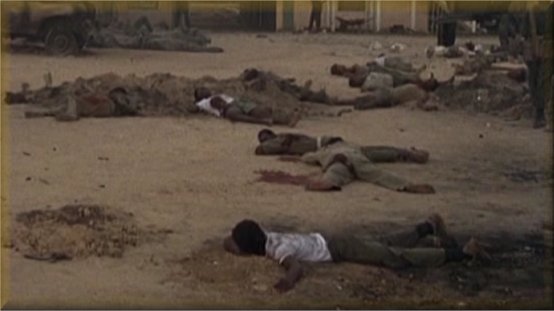 hem would find that these scenes
would stay with them
for the rest of their lives. Amongst the dead and wounded another terrible sight
greeted the South Africans, a toddler was wondering amongst the carnage looking
for his mother or family members, and his cries were intermingling with the
cacophony of shrieks and groans emanating from the maimed and wounded lying in
the charnel house in front of the buildings , this heartrending sight started to
effect some of the soldiers, some who were crying openly, a South African
Soldier picked up the child and ran with him to the relative security of the
hospital and left him there in the company of three other children, aged between
8 and 11, this was not the sanitized news reports one saw on television, but war
in all its savagery and brutality. One had to question the motives of those who
allowed children into a terrorist training camp. The South Africans soon
realised that the "SWAPO HQ " was in fact a quartermasters store,
filled with rather outdated Soviet small arms , and to cap it all quite a number
of muzzle loaders, what SWAPO had intended to do with these, heaven knew. The most bizarre find was a room full of shoes of all shapes and sizes, the South
Africans speculated that SWAPO must have had a policy of using shoes as a
bartering object with the local population .
hem would find that these scenes
would stay with them
for the rest of their lives. Amongst the dead and wounded another terrible sight
greeted the South Africans, a toddler was wondering amongst the carnage looking
for his mother or family members, and his cries were intermingling with the
cacophony of shrieks and groans emanating from the maimed and wounded lying in
the charnel house in front of the buildings , this heartrending sight started to
effect some of the soldiers, some who were crying openly, a South African
Soldier picked up the child and ran with him to the relative security of the
hospital and left him there in the company of three other children, aged between
8 and 11, this was not the sanitized news reports one saw on television, but war
in all its savagery and brutality. One had to question the motives of those who
allowed children into a terrorist training camp. The South Africans soon
realised that the "SWAPO HQ " was in fact a quartermasters store,
filled with rather outdated Soviet small arms , and to cap it all quite a number
of muzzle loaders, what SWAPO had intended to do with these, heaven knew. The most bizarre find was a room full of shoes of all shapes and sizes, the South
Africans speculated that SWAPO must have had a policy of using shoes as a
bartering object with the local population .
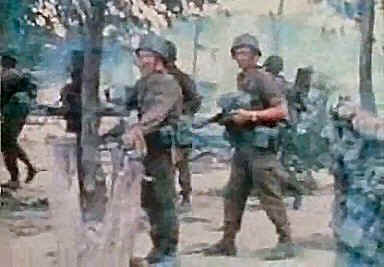 Once the building had been secured Brandt returned to the
hospital and set up his HQ , and at last the South Africans could establish
Comms with the flying command post who in turn could relay messages to Ondangwa in South West Africa .There had
been a steady increase in the amount of sniping, the South Africans suspected
that the snipers were in a tall tree about 100 metres from the Hospital,
the redoubtable Buks van As set up a LMG and opened fire at the
tree , after a couple of bursts, three bodies plus their Dragonov sniper rifles
tumbled out and hit trhe road with satisfying thumps, the sniping ceased.....
Once the building had been secured Brandt returned to the
hospital and set up his HQ , and at last the South Africans could establish
Comms with the flying command post who in turn could relay messages to Ondangwa in South West Africa .There had
been a steady increase in the amount of sniping, the South Africans suspected
that the snipers were in a tall tree about 100 metres from the Hospital,
the redoubtable Buks van As set up a LMG and opened fire at the
tree , after a couple of bursts, three bodies plus their Dragonov sniper rifles
tumbled out and hit trhe road with satisfying thumps, the sniping ceased.....
Clearing the engineer complex proved pretty easy, none of the
SWAPO terrs chose to stand and fight, and those who unwisely chose to make a
stand died .. The south Africans had a nasty surprise when a ammunition dump
that had been hidden underneath a car wreck blew up with a massive roar, that
had everybody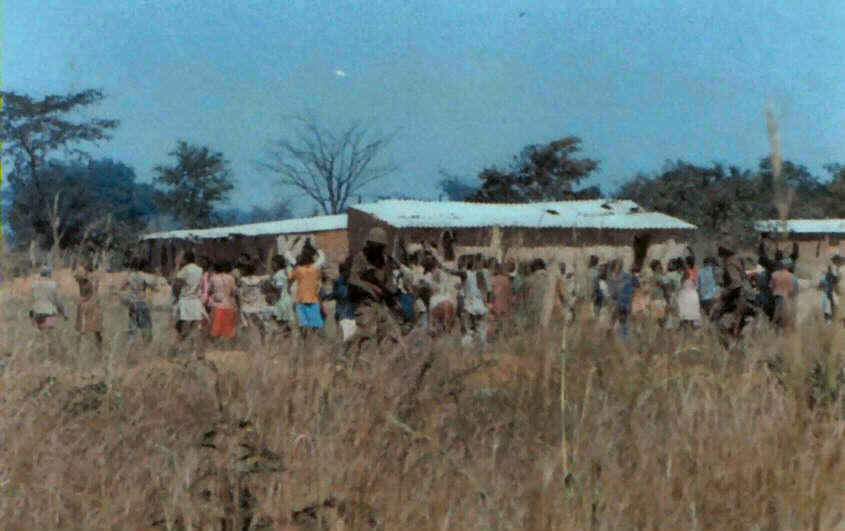 scrambling for cover, Delta moved through their objective , and
immediately came under fire from Bravo company, who was sweeping towards the
trenches on the Eastern perimeter, a few choice Afrikaans swear-words quickly
identified them as being friendly forces, and the firing ceased, luckily nobody
had been hit.
scrambling for cover, Delta moved through their objective , and
immediately came under fire from Bravo company, who was sweeping towards the
trenches on the Eastern perimeter, a few choice Afrikaans swear-words quickly
identified them as being friendly forces, and the firing ceased, luckily nobody
had been hit.
HQ company under command of Lt Peters laid some landmines at the intersection South of Cassinga , and lay in ambush,, distances were paced out, lanes of fire were established , and then they hunkered down for an interminable wait, it would not be long before they would be involved.
Charlie company took up positions along the eastern fringe, and
to their dismay found out that the trees around Rennex were far taller than they
appeared on the aerial
photographs, and 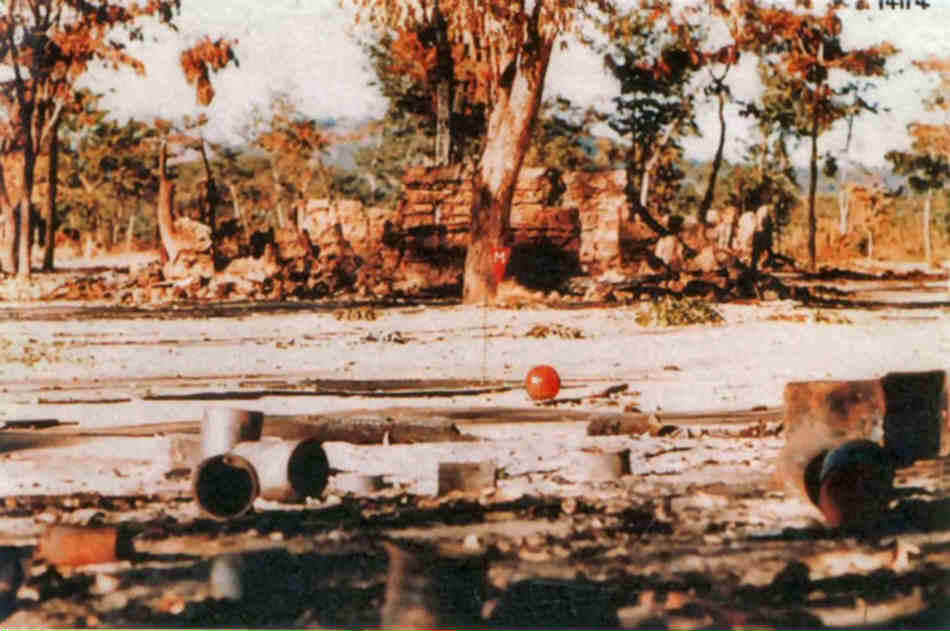 this
stopped them from seeing how the battle was progressing, all they could do was
sit and listen, Monty Forbes heard an attack coming in from the south and
decided that orders or no orders he had to do something. The troops shook
themselves into a line and Charlie attacked the trenches on the eastern
perimeter, this proved to be relatively easy although there was always the
danger that as the axis of advance had been changed this action might have
resulted in a Blue on Blue contact.
this
stopped them from seeing how the battle was progressing, all they could do was
sit and listen, Monty Forbes heard an attack coming in from the south and
decided that orders or no orders he had to do something. The troops shook
themselves into a line and Charlie attacked the trenches on the eastern
perimeter, this proved to be relatively easy although there was always the
danger that as the axis of advance had been changed this action might have
resulted in a Blue on Blue contact.
As Charlie took the trenches they discovered a straight trench about 3 metres deep, running north-northeast that they were unaware of, this proved to be death-trap for the SWAPO Terrs caught inside it, after the firing died down 90 enemy dead were counted, by this time Charlie was right opposite the orchard, they advanced to about 30 metres over the trench SWAPO had tried to use as an escape route, and then drew back to their original position.
Throughout all of this the anti-aircraft machine guns which SWAPO were deploying in a ground role were pinning down Bravo, an earlier attack by 14 men trying to silence these had been beaten back, leaving one man dead near DZ Carolina, McQueen and Corporal PG Du Pisanie eventually recovered his body under fire. Under the cover of a 60mm mortar barrage ,one of the dead soldiers' comrades crawled up to the lip of the trench from where the dead man had been shot, and dropped 2 hand grenades amongst the group of male and female SWAPO Terrs congregated inside, there was a satisfying double explosion, which sorted out that little problem.
To add to Bravo's woes they started to receive sniper fire from
the trees to the rear of their left flank, luckily this fire was inaccurate, one
terr hidden in the trees was spotted and the trees were took under
fire , the trunks and branches offered no defense against the 7,62 X 51 mm round
of the Parabats' rifles, and soon the terrs were " falling out  like
ripe a
like
ripe a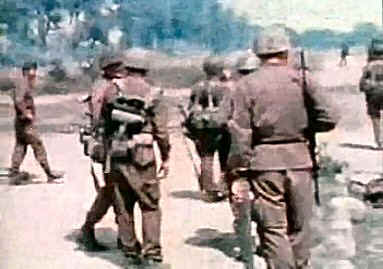 pples". Despite this Bravo was well and truly in trouble, being
pinned down by 60mm mortars, RPD's and the fire from the antiaircraft gun,
Bravo could see the gun about 200 metres away , but it might as well have been
10 klicks away as there was almost nothing they could do to resolve this thorn
in their side, all they had was one 60mm mortar tube and 3 bombs, a rocket
launcher, but no rockets. Bravo started firing at the antiaircraft gun with
small-arms, this almost proved fatal, as their target immediately cut loose in
retaliation, luckily for Bravo they were in dead ground, and the hail of fire
passed harmlessly overhead , as the Swapo gunners could not depress thei gun
sufficiently, yet it was a sobering experience.
pples". Despite this Bravo was well and truly in trouble, being
pinned down by 60mm mortars, RPD's and the fire from the antiaircraft gun,
Bravo could see the gun about 200 metres away , but it might as well have been
10 klicks away as there was almost nothing they could do to resolve this thorn
in their side, all they had was one 60mm mortar tube and 3 bombs, a rocket
launcher, but no rockets. Bravo started firing at the antiaircraft gun with
small-arms, this almost proved fatal, as their target immediately cut loose in
retaliation, luckily for Bravo they were in dead ground, and the hail of fire
passed harmlessly overhead , as the Swapo gunners could not depress thei gun
sufficiently, yet it was a sobering experience.
In the meantime Witt and his independent rifle platoon attacked
the SWAPO trenches on the east-west of SWAPO's HQ. This was dirty and bloody man
to man fighting, reminiscent of the trenches of WWI , bayonet, rifle butt, and
grenade, smoke, dust and blood everywhere. The air was filled with the barking
of rifles, the crump 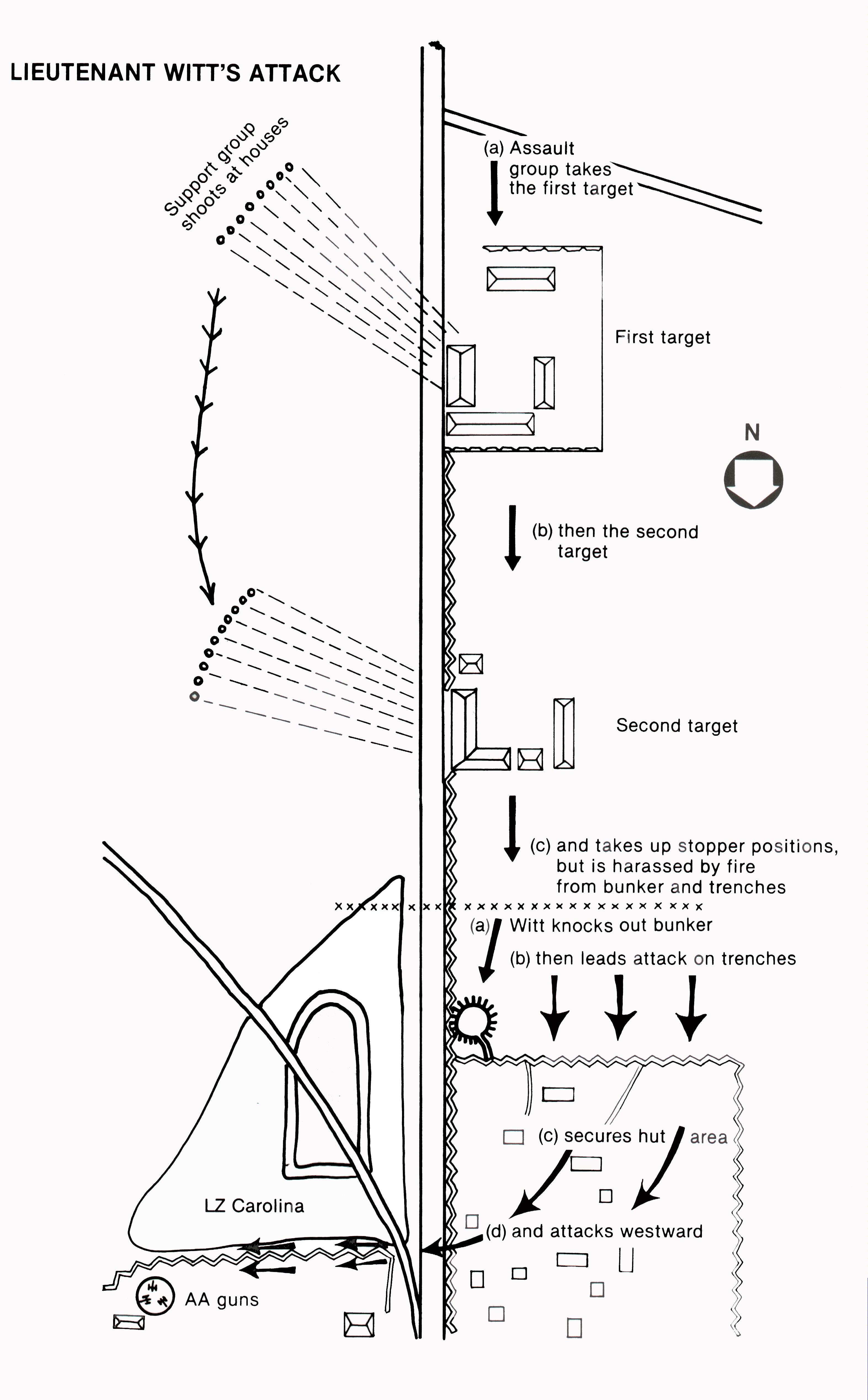 of grenades, the yammering of machine guns, the shouts and
curses of the combatants, but above all many of the South Africans would recall
the cries of the the dying and wounded, and especially the terrified screams of
the women and children who SWAPO had with them in the trenches, as soon as these
would try to escape and scramble out, the "heroic Freedom Fighters"
would pull them back in, and try to use them as human shields. It was bloody
butchers work, like the professionals they were, Witts' men completed their grim
task, leaving a trail of dead and dying in their wake.
of grenades, the yammering of machine guns, the shouts and
curses of the combatants, but above all many of the South Africans would recall
the cries of the the dying and wounded, and especially the terrified screams of
the women and children who SWAPO had with them in the trenches, as soon as these
would try to escape and scramble out, the "heroic Freedom Fighters"
would pull them back in, and try to use them as human shields. It was bloody
butchers work, like the professionals they were, Witts' men completed their grim
task, leaving a trail of dead and dying in their wake.
Bravo Company managed to make contact with Alpha Company, but unlike Bravo, Alpha had plenty of mortar bombs, but could not see the troublesome Anti Aircraft position , despite this Sergeant Veldsman decided that he would be able to neutralize the enemy position. With McQueen acting as observer, Veldsman dropped the first bomb in the tube, and almost immediately McQueen got on the radio advising him that his bomb had almost dropped on them, only to be told that that was impossible as Veldsmans' bombs were still in the air, and that it must have come from a SWAPO mortar position the South Africans were unaware of.
The SWAPO gunners manning the Anti Aircraft gun were brave, as soon as one of their number fell there was another to take his place , and the South Africans afterwards would reminisce about the heroism of these men who seemed impervious to the fact that they were being knocked over like ninepins within a matter of minutes, once they crewed the gun, yet as soon as one man fell , another took his place.
Bravo suffered their second dead near the Anti Aircraft position, and an unknown Troep carried his dead comrade over his shoulders into the Casualty area, Cassinga was starting to represent a scene from Dante's Inferno.... Black acrid smoke from the burning huts was mingling with the smell of dead bodies being consumed in the fires, bullets ricocheting of walls and tearing out chunks out of the walls that were still standing , corpses strewn about as if tossed by a careless hand, the groans and cries of the wounded terrs, added to this the smell of human waste as most of the dead had soiled themselves when dying, this was War, not the sanitized pictures one would see on SABC TV, but the utter horror that occurs when one human being kills another in anger. Those who died, did not die like heroes without a murmur and a steely glint in their eyes for an ideal, they died crying for their mothers and fathers, cursing whatever God they believed in for abandoning them, they died writhing in agony, in the dirt of Africa, all because they believed the lies that Sam Njoma had told them.
32 Battalion
Copyright Cobus Venter 2006
..